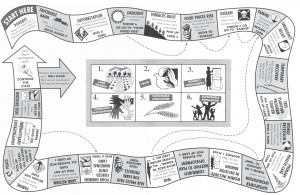Game: Tools of Hope

adapted by Carmela Federico
In the Tools of Hope Game, students explore challenges in the lives of farmers in developing countries in order to learn about the causes of hunger and the relationship between hunger and sustainable development.
Subject areas: social studies, science, language arts
Key concepts: subsistence farming, equity, sustainable development, the role of women in development, the status of women in developing countries
Skills: awareness, empathy, analysis
Location: indoors
Time: 30 minutes for game, longer for follow-up
Materials: per group: 1 game board (download), 1 die, 4 different playing pieces; per player: 1 set of Tools of Hope cards
Preparation
Make a set of Tools of Hope cards for each student. Write the Rules of the Game on the board or enlarge and copy them for each group.
Rules of the game
• Players take turns rolling the die, advancing their playing pieces on the game board, and following the instructions on the squares they land on.
• Some squares direct players to return a Tools of Hope card. If a player does not have a card to return, he/she loses one turn.
• Each player is allowed to hold only one Tools of Hope card from each category at any one time.
• When a player has collected all six cards, he/she has broken the cycle of hunger.
Procedure
1. Divide the class into groups of four, and give each group a game board, one die, four playing pieces, and four sets of Tools of Hope cards. Have students place the cards face up in the appropriate categories in the center of the game board.
2. Inform students that each player represents a farming village. Their aim is to break the cycle of hunger by collecting the tools necessary for a better future, represented by the Tools of Hope cards. Review the rules of the game.
3. In their groups, students take turns rolling the die and following the instructions as they land on squares on the game board.
Follow-up
1. After the game, lead a discussion by asking students: What things helped you break the cycle of hunger? What things prevented you? How true to life do you think the game is? What role does our country play in creating or ending hunger in subsistence farming villages in developing countries?
2. Analyze the many challenges faced by farmers in developing countries: poverty, inappropriate development, soil erosion, drought, deforestation, lack of health care, war, debt to other countries, being forced onto poor land, and powerlessness to set the prices for their goods. Explain why each challenge exists and how it contributes to hunger. Students could research some of these problems for discussion in future classes.
3. Discuss the factors that combat hunger: land reform, tree planting, community planning and decision making with involvement of women, good primary health care, population sustainability, and peace. Again, students could research these.
4. Invite students to make posters illustrating their understanding of the causes of and solutions to hunger in developing countries. Place the posters around the school to educate the rest of the school community on these issues.
Carmela Federico is Program Manager at the New Jersey Higher Education Partnership for Sustainability. The Tools of Hope game was adapted, with permission, from Church World Service, “We Can Do That, Too!,” Hunger Education Activities That Work.
Excerpted from Teaching Green: The Middle Years.
Leave a Reply
You must be logged in to post a comment.





